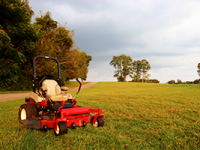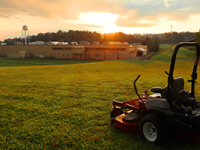Utilizing Video Input to Improve Operational Safety of Heavy Equipment
 The ability to see behind a machine and work area is crucial to improve safety in the operation of heavy equipment and machinery. Just as in automobiles, the capability to see behind a mine haul truck, forklift, reach stacker or other machinery is important when maneuvering. Additionally, the ability to see the work area including the fork placement on a forklift, grain conveyor on a harvester or the top hatch on a refuse side loader truck is also important for safety and to help improve operator productivity. Having a camera in place to see if the conveyor is clogged or if the top hatch is blocked can help reduce time, as well as allowing the operator to see potentially dangerous or damaging conditions before they become critical.
The ability to see behind a machine and work area is crucial to improve safety in the operation of heavy equipment and machinery. Just as in automobiles, the capability to see behind a mine haul truck, forklift, reach stacker or other machinery is important when maneuvering. Additionally, the ability to see the work area including the fork placement on a forklift, grain conveyor on a harvester or the top hatch on a refuse side loader truck is also important for safety and to help improve operator productivity. Having a camera in place to see if the conveyor is clogged or if the top hatch is blocked can help reduce time, as well as allowing the operator to see potentially dangerous or damaging conditions before they become critical.
More and more heavy equipment, construction machinery, specialty trucks and agriculture equipment are using operator displays in the cab to improve the machine interface. Although dedicated video screens are readily available, having an additional screen for just video, adds cost and can inhibit the operator’s visibility. The ability to integrate video signals onto screens offers a cost-effective solution, as well as improving operator visibility by reducing the number of screens in the cab.
The PHD50 and the PHD70 touchscreen displays offer the ability to not only perform the operator interface for engine and machine diagnostics, status and configuration, they also support video input directly to the screens. The PHD50 supports a single video feed, while the PHD70 support two video feeds.
Both PHD models can perform logic and calculations to allow the video screen to show dynamically, based on events or fault conditions. For example, if the loading arms on a refuse truck are raised, but the top hatch is closed, the top hatch video camera feed can automatically appear on the screen to inform the operator of the condition. When a mine haul truck is put into reverse travel, the backup camera feed can automatically appear, or if the chipping wheel on a whole tree chipper signals an overload, the workspace camera can automatically appear to show the operator what is causing the overload. This can dramatically improve the machine efficiency by allowing the operator to proactively deal with possible dangerous or work stopping conditions.


In this example, the PHD50_Camera.zip and PHD70 Camera.zip files include an example application program that shows how to implement the single video input into the PHD50 and both video inputs into the PHD70. In addition to the video input(s), the example has implemented the following features:
- Flip the video screen for backup camera orientation.
- Backlight adjustment with Auto Backlight for night and day operation.
- Selection button to select video 1 or 2 on the PHD70.
- Entering sleep mode and using a screen touch as a wake signal for power saving operation.
- This example uses an NTSC analog camera, but PAL is also supported for broader market opportunities around the world.
This application example can be used as is for basic video screens or can be modified or included in another PHD application to incorporate the advantages of video screens into an application to accompany engine and machine parameter settings, showing fault codes and overall status and gauges. The example contains the graphical content for the video feed selection, the script to invert the video image and the screen to set the back-light intensity using Crank Storyboard and functionality written in Lua script.
To learn more about how PHD displays can help equipment operators, view our product literature, technical specifications and reference materials.

Article contributed by Edward Polzin, regional application engineer – central,
Electronic Controls Division, Parker Hannifin Corporation.
Related, helpful content for you:
Using a Mobile Display as a Dynamic Numeric Keypad Input Device
Three Ways to Improve the Operation of Your Proportional Valve
Meeting Your Work Truck’s Demand for More Hydraulics Space
Source: Parker Feed





